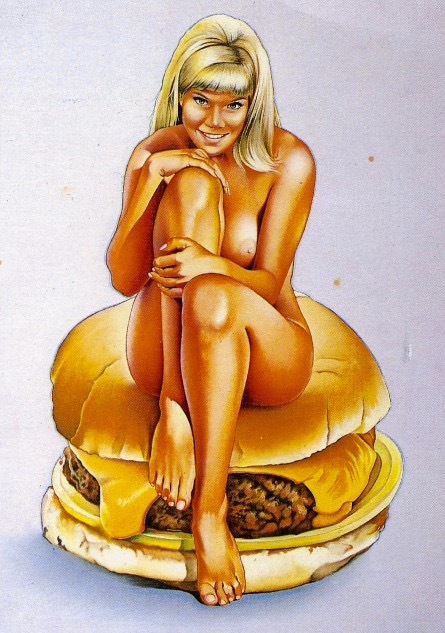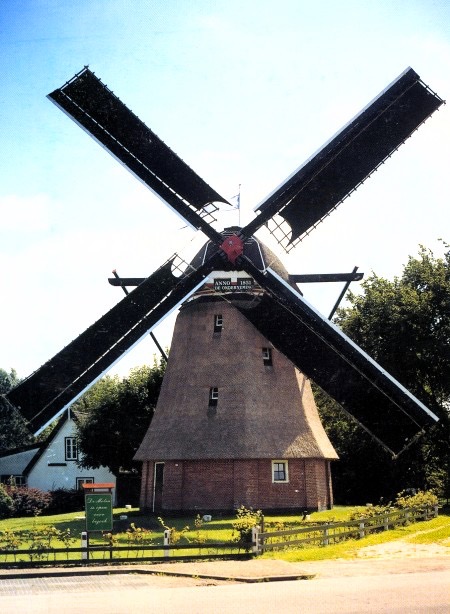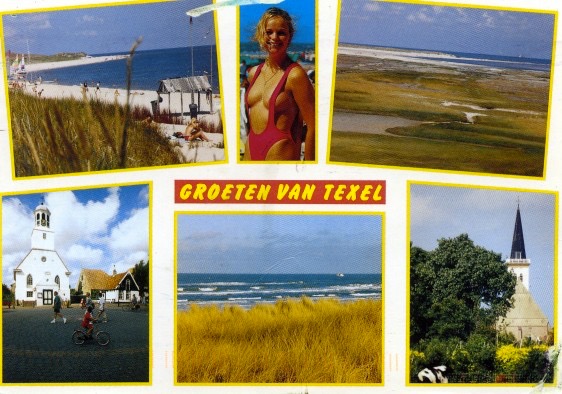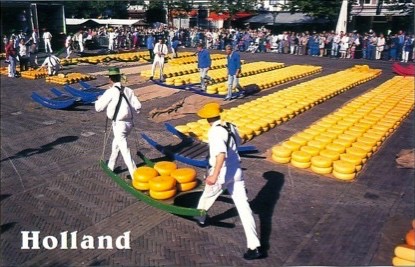Peri and Mom's European Trip (2008)
This travelogue features a bicycling tour of North Holland with a subsequent visit to Paris a brief stopover in London.
Contents
1. Amsterdam
The Nederlands is an exercise in being reasonable. While Londoners may drive on the left, the traffic controls and rules were familiar; in the Nederlands they were out the window. Intersections primarily work on a yielding basis, pedestrians cross roads anywhere, and can do so a piece at a time using islands between lanes. Bikes have their own lanes that shift from left to right to opposing sides. Intersections are a ballet of movement with protocol, skill, timing and a notable collaborative consideration leading to everyone moving more fluidly than our way. Learning to adapt is critical so you don't get run over.
We arrived early on Wednesday, before Hotel Kooyk opened, so we headed to breakfast. Owing to the more northern location, days are very long and it was light to about 23:00. Thus, not many breakfast places open until about 9:00. Being hungry, we went to the only place we found that was open.
Despite the very pricey pancake breakfast on the morning of arrival-- about $40-- prices were otherwise reasonable. Except for the toilet, which near everywhere required payment—usually €0.20-€0.25 ($0.30-$0.40), but occasionally as much as €1 ($1.50). Some places waived the fee for patrons of their businesses, but many did not.
The hotel was an old dutch home. They build very vertical. We were on the 2nd floor (with ground being 0). To save space, they built incredibly steep stairwells. Like, 10cm step to 15cm inch rise or more-- really, more of a stairwell-shaped ladder. Thus, I suspect it may very well have been the Dutch who invented handrails. Each stairwell was equipped with two, both very strong, which were very effective (essential!) in making stairwells usable.
While in Amsterdam, we visited the Van Gogh museum, which was helpful in differentiating realism and impressionism. The museum also had tasty apple-pie like pastries in the eatery when we were done. There was some good art, but honestly, I liked some of Van Gogh's contemporaries more than him.

We also visited the Red Light District, and there really are sex workers standing in windows, ready to sit on your meat for money. They even have red lights at night. They also have venues offering live porn (people up on stage doing it, right now) as well a plenty of lingerie and sex toy shops. I think mom objected to the toy shops, which had dildos and vibrators out on display in windows; I thought being so straightforward and honest about sex was wonderful.
2. Cycling North Holland
The bike tour was run by Bike and the Like. We stayed on a boat called the Feniks, operated by the couple that owns the boat. Rooms were small (it's a boat!), but nicely maintained. Food was good, and the tour was a great deal given that the $1,000 tag included all the food and lodging for the week. Well, except for the numerous cycling ice-cream breaks.
Avid cyclists, the Dutch have simple, single speed bikes (all that's necessary, given the flat terrain) with solid tires to withstand brick and stone street abuse. They're very practical, equipped with baskets, child carriers, racks, and fenders to ensure you don't get road spray while cycling to work in the suit. And yes, us tourists with the 21-speed rentals did get passed by locals on their beaters.
All bikes are equipped (straight off the showroom, judging by our visit to a bike shop) with a ubiquitous frame lock (also known as a ring lock), which snaps shut and locks the rear wheel when the key is removed; very convenient.
The Nederlands was my favorite part of the European trip. Okay, I'm simple, but we went into a windmill (molen) and saw it operate. Now that's beauty-- and function too.

With the familiar octagonal reed-covered exterior, molen have various internal mechanisms depending on need. Mostly, either grinding (for flour or animal feed) or pumping water (because their country is flat and drains poorly; also the reason for wind- rather than water-driven grinding wheels).
The four sails can have their canvas and wood covers adjusted for catching the right amount of wind, and even have a gentle curve to optimize their airfoil behavior. The top turrets around, with a W-shaped mechanism on the back to lever it around. Individual mechanisms (such as flour grinding stones, feed grinding stones, etc.) friction fit into place, so the operator can engage and disengage their wooden gears with a good shove. Eli Whitney and your interchangeable parts, eat your heart out! The Dutch had standardized parts on the mills ages before the cotton gin or muskets. As the remaining 1100 windmills become museums, some get cannibalized for parts-- and owing to standardization, things fit.

With all their canals also go drawbridges, which are equally simple and functional. Whereas a drawbridge in the states is a major design and development effort, the Dutch have a simple design that they just keep using. Imagine a giant letter "T", with a counterweight at one side of the "T" and a chain to the bridge deck off the other end. To lift the bridge deck, just tilt the top of the "T". In a country where a drawbridge is a multi-million dollar project waiting to happen, the Dutch simplicity makes us look foolish. Along the west coast of North Holland are "the dunes"-- sand dunes which they've built bike paths through. Cycling through them, I kept having a sense of a miniature pasture land from the BBC series _All Creatures Great and Small_ -- it must be a result of easier, faster weathering processes, along with the low scrub and grass. It also reminded me of miniature mountains-- knobby, craggy in a fractal kind of way, with miniature trees.

In Alkmaar (home to a huge cheese market), I did some wandering on my own and passed through that city's Red Light District. A worker there chatted me up, although there was a communication barrier because she didn't speak much English—which is unusual, as a country rooted in trading the Dutch are very multilingual. Anyhow, I wasn't able to figure out what she wanted with 'liquor', which in retrospect was probably an offer of licking, whether for or by me I couldn't say. She was definitely going for a hard sell, though, and if I didn't have my cynical capitalism resistance I may have ended up buying a bit of fun.
3. Paris
The French government has changed so many times, they benefit from revolving doors on their castles. I now better understand the Simpson's quip, "cheese-eating surrender monkeys." Their propensity to surrender may be why Paris has survived intact: you really wouldn't need to destroy much before you're in power.
On the other hand, once you're in power, it's time to watch out. If there's not another leader coming in to take over, then the people will riot to express their dismay with your leadership. Whether deposed or defeated, you can always raise another army and take control back again. Heck, if you say the right thing you can get the existing army on your side, avoiding the need to even raise one. Unless, of course, they've decided to chop your bourgeois head off.
The Parisians seem to be great stone workers, creating all kinds of stone buildings and statuary. They've tunneled all over beneath the city for hundreds of years, creating the necessity of a bureau responsible for maintaining underground tunnel quality to prevent cave-ins.
They've also used their tunneling skills to create an amazing subway system twisting and winding beneath the city. At €1.10 ($1.50) a trip, it's cheap and easy. Contrast with London.
Food is expensive, but compares to big-city U.S. Prices.
Museums are plentiful, with rates varying, but few are free except on Sundays (or particular Sundays).
4. London
London is by far the most expensive city we visited. Burger & chips ran £20 (approximately $40). One trip bus far, £2 ($4). Underground, £4 ($8). An all-day pass on transit is £5.80 ($12), although an all-day bus pass is only £3.50 ($7). After expecting the cheap transit found elsewhere, getting around really seemed very pricey. On the other hand, museums such as the national gallery were free.
We went on a walking tour of Westminster, home of Parliament and the Royals. We went up in "the Eye", the giant Ferris wheel, which has a beautiful view. We ran out of time to see the old city, unfortunately. We did try the local food, and in fact English cooking is everything it's described as and worse. It's appalling. Vegetables boiled until they taste... ugh. It does improve cabbage though.
In addition to being pricey, the London transit system is complex. By far, the most complex I've encountered. The Underground is easy enough, but there are so many bus routes--literally hundreds--that each Tube station has a different bus map, listing where its buses go. As they're all in schematic form (as opposed to geographic), it becomes even more confusing to the beginner, although if you knew London I can see how it's a great system (more of a steep learning curve, as opposed to dunderheadedness of, say, RGRTA).
Paying is as confusing as routing. There's single rides, return rides, all-day passes, 24-hour passes, multi-day passes, all-mode and bus-only variations, multi-day options, and travel zones with different rates. They have an E-ZPass-like travel card called the Oyster, which has a waived $5 admin setup fee but may have a $3 fee still, and you may or may not need to provide a passport-sized photo to go with it. It allegedly retroactively bills you the minimum fees that are appropriate, but given the unclear setup fees we skipped it.
London's recent history is pretty straightforward. There was a King or Queen, there was Parliament. A few times people tried to overthrow this to no avail. They occasionally held wars and had an empire that shrank and grew, but that's what you do, right? Contrast with Paris.
5. Wrap-up
As my European vacation comes to a close, some things I found out:
- Two or three days is not enough to see a city. The first day or so is getting in, getting settled, learning the way about. Given time allocated to "overview sightseeing," there isn't much left to see specifics or really get a flavor for a city.
- Our power standard--consistent outlets between the US and Canada-- is a rarity. Although 250V 50Hz is standard in Europe, the outlets are not. Every country has a different variation of big, clunky power connectors, requiring different power cords, appliances, multi-plug adapters, etc. What a nuisance!
